Exploring Current Status and Evolutionary Trends on the Paid Use of State-Owned Forest Resources in China: A Bibliometric Perspective
Abstract
:1. Introduction
2. Data Sources and Methods
2.1. Data Sources
2.2. Methodology
3. Results
3.1. Basic Feature Analysis
3.1.1. General Statistics
3.1.2. Authors
3.1.3. Funding
3.1.4. Institutions
3.1.5. Journals
3.2. Bibliometric Analysis
3.2.1. Keywords and Co-Occurrence Matrix
3.2.2. Cluster Analysis and MDS
3.2.3. Co-Occurrence Network Analysis
3.2.4. Developing Trend Analysis
3.3. Content Theme Analysis
4. Discussion
5. Conclusions and Outlook
5.1. Conclusions
5.2. Outlook
Author Contributions
Funding
Institutional Review Board Statement
Informed Consent Statement
Data Availability Statement
Acknowledgments
Conflicts of Interest
References
- United Nations Department of Economic and Social Affairs. United Nations Strategic Plan for Forests, 2017–2030. 2017. Available online: https://www.un.org/esa/forests/wp-content/uploads/2016/12/UNSPF_AdvUnedited.pdf (accessed on 23 March 2022).
- United Nations Department of Economic and Social Affairs. United Nations Forest Instrument. 2016. Available online: https://www.un.org/esa/forests/documents/un-forest-instrument/index.html (accessed on 23 March 2022).
- United Nations Department of Economic and Social Affairs. Transforming Our World: The 2030 Agenda for Sustainable Development. 2015. Available online: https://sdgs.un.org/2030agenda (accessed on 11 March 2022).
- State Council of China. Guiding Opinions on the Reform of the System of Paid Use of Natural Resource Assets Owned by the Whole People. Available online: http://www.gov.cn/zhengce/content/2017-01/16/content_5160287.htm (accessed on 3 March 2022).
- Ceccherini, G.; Duveiller, G.; Grassi, G.; Lemoine, G.; Avitabile, V.; Pilli, R.; Cescatti, A. Abrupt increase in harvested forest area over Europe after 2015. Nature 2020, 583, 72–77. [Google Scholar] [CrossRef] [PubMed]
- FAO. Global Forest Resources Assessment 2020—Key Findings. 2020. Available online: https://www.fao.org/documents/card/en/c/ca8753en (accessed on 20 March 2022). [CrossRef]
- National Forestry and Grassland Administration. China Forest Resources Report (2014–2018); China Forestry Press: Beijing, China, 2019; pp. 5–6. [Google Scholar]
- The Suggestions on Formulating the Fourteenth Five-Year Plan for National Economic and Social Development and the Long-Term Goals for 2035. Available online: http://www.gov.cn/zhengce/2020-11/03/content_5556991.htm?trs=1 (accessed on 11 March 2022).
- Costanza, R.; D’Arge, R.; De Groot, R.; Farber, S.; Grasso, M.; Hannon, B.; Limburg, K.; Naeem, S.; O’Neill, R.V.; Paruelo, J.; et al. The value of the world’s ecosystem services and natural capital. Nature 1997, 387, 253–260. [Google Scholar] [CrossRef]
- Diaz-Balteiro, L.; Alonso, R.; Martínez-Jaúregui, M.; Pardos, M. Selecting the best forest management alternative by aggregating ecosystem services indicators over time: A case study in central Spain. Ecol. Indic. 2017, 72, 322–329. [Google Scholar] [CrossRef]
- Karlsson, M.; Wolf, A. Using an optimization model to evaluate the economic benefits of industrial symbiosis in the forest industry. J. Clean. Prod. 2008, 16, 1536–1544. [Google Scholar] [CrossRef]
- Hardin, G. The tragedy of the commons: The population problem has no technical solution; it requires a fundamental extension in morality. Science 1968, 162, 1243–1248. [Google Scholar] [CrossRef] [Green Version]
- Lambini, C.K.; Nguyen, T.T. A comparative analysis of the effects of institutional property rights on forest livelihoods and forest conditions: Evidence from Ghana and Vietnam. For. Policy Econ. 2014, 38, 178–190. [Google Scholar] [CrossRef]
- Liu, S.; Xu, J. Livelihood mushroomed: Examining household level impacts of non-timber forest products (NTFPs) under new management regime in China’s state forests. For. Policy Econ. 2019, 98, 44–53. [Google Scholar] [CrossRef]
- Zhang, C.; Fang, Y.; Chen, X.; Congshan, T. Bibliometric Analysis of Trends in Global Sustainable Livelihood Research. Sustainability 2019, 11, 1150. [Google Scholar] [CrossRef] [Green Version]
- Pelyukh, O.; Lavnyy, V.; Paletto, A.; Troxler, D. Stakeholder analysis in sustainable forest management: An application in the Yavoriv region (Ukraine). For. Policy Econ. 2021, 131, 102561. [Google Scholar] [CrossRef]
- Laakkonen, A.; Hujala, T.; Pykäläinen, J. Integrating intangible resources enables creating new types of forest services-developing forest leasing value network in Finland. For. Policy Econ. 2019, 99, 157–168. [Google Scholar] [CrossRef]
- Song, M.; Zhu, S.; Wang, J.; Wang, S. China’s natural resources balance sheet from the perspective of government oversight: Based on the analysis of governance and accounting attributes. J. Environ. Manag. 2019, 248, 109232. [Google Scholar] [CrossRef] [PubMed]
- Nielsen, A.B.; Olsen, S.B.; Lundhede, T. An economic valuation of the recreational benefits associated with nature-based forest management practices. Landsc. Urban Plan. 2007, 80, 63–71. [Google Scholar] [CrossRef]
- Koponen, K.; Soimakallio, S.; Kline, K.; Cowie, A.; Brandão, M. Quantifying the climate effects of bioenergy–choice of reference system. Renew. Sustain. Energy Rev. 2018, 81, 2271–2280. [Google Scholar] [CrossRef]
- Benedictus, R.; Miedema, F.; Ferguson, M.W.J. Fewer numbers, better science. Nature 2016, 538, 453–455. [Google Scholar] [CrossRef]
- Demyanyk, Y.; Hasan, I. Financial Crises and Bank Failures: A Review of Prediction Methods. Omega 2010, 38, 315–324. [Google Scholar] [CrossRef] [Green Version]
- Zambrano Farias, F.; Valls Martínez, M.C.; Martín-Cervantes, P.A. Explanatory Factors of Business Failure: Literature Review and Global Trends. Sustainability 2021, 13, 10154. [Google Scholar] [CrossRef]
- Wei, J.; Zhao, K.; Zhang, L.; Yang, R.; Wang, M. Exploring development and evolutionary trends in carbon offset research: A bibliometric perspective. Environ. Sci. Pollut. Res. 2021, 28, 18850–18869. [Google Scholar] [CrossRef]
- Pankowska, M. Information Technology Outsourcing Chain: Literature Review and Implications for Development of Distributed Coordination. Sustainability 2019, 11, 1460. [Google Scholar] [CrossRef] [Green Version]
- Wang, X.; Xu, Z.; Su, S.-F.; Zhou, W. A comprehensive bibliometric analysis of uncertain group decision making from 1980 to 2019. Inf. Sci. 2021, 547, 328–353. [Google Scholar] [CrossRef]
- Bouzembrak, Y.; Klüche, M.; Gavai, A.; Marvin, H.J. Internet of Things in food safety: Literature review and a bibliometric analysis. Trends Food Sci. Technol. 2019, 94, 54–64. [Google Scholar] [CrossRef]
- Cui, L.; Liu, W.; Yan, L.; Zhang, H.; Hou, Y.; Huang, Y.; Zhang, H. Development of Bibliographic Information Co-occurrence Mining System in Document Database. Mod. Libr. Inf. Technol. 2008, 24, 70–75. [Google Scholar] [CrossRef]
- Liu, J. Whole Network Analysis: A Practical Guide to UCINET Software, 2nd ed.; People’s Publishing House: Shanghai, China, 2014; pp. 144–184. [Google Scholar]
- Chen, C. CiteSpace II: Detecting and visualizing emerging trends and transient patterns in scientific literature. J. Am. Soc. Inf. Sci. Technol. 2006, 57, 359–377. [Google Scholar] [CrossRef] [Green Version]
- Li, J.; Chen, C.M. CiteSpace: Science and Technology Text Mining and Visualization; Capital University of Economics and Business Press: Beijing, China, 2017; pp. 112–113. [Google Scholar]
- Yin, Z.J.; Liu, M.; Zhang, L.S. Analysis of Knowledge Graph and Hot Topics in Domestic Green Space Planning Research—Based on the Perspective of Bibliometrics Co-word Analysis. Mod. Urban Res. 2020, 10, 97–104. [Google Scholar] [CrossRef]
- De Solla Price, D.J. Little Science, Big Science; Columbia University Press: New York, NY, USA, 1963; pp. 48–52. [Google Scholar]
- Luo, M.; Zhu, X.Z. Research on the composition of low-carbon policies in my country based on co-word analysis. J. Manag. 2014, 11, 1680–1685. [Google Scholar] [CrossRef]
- Bradford, S.C. Classic Paper: Sources of Information on Specific Subjects. Collect. Manag. 1976, 1, 95–104. [Google Scholar] [CrossRef]
- Donohue, J.C. Understanding Scientific Literatures: A Bibliometric Approach; The MIT Press: Cambridge, MA, USA, 1973; pp. 49–50. [Google Scholar]
- Mishra, S.; Torvik, V.I. Quantifying Conceptual Novelty in the Biomedical Literature. Digit. Libr. Mag. 2016, 22, 9–10. [Google Scholar] [CrossRef]
- Yang, H. Application of Cluster Analysis Based on SPSS in Industry Statistical Data. Master’s Thesis, Jilin University, Changchun, China, 2013. [Google Scholar]
- Zhang, Y.; Guo, H.Y.; Chen, J.Q. Analysis of the current situation of data mining research in my country—Based on the perspective of co-word analysis. Inf. Sci. 2011, 10, 1589–1593. [Google Scholar]
- Freeman, L.C. Centrality in social networks conceptual clarification. Soc. Netw. 1978, 1, 215–239. [Google Scholar] [CrossRef] [Green Version]
- Zhang, W.M. Improving the Value Realization Mechanism of Ecological Products—Based on the Investigation of Fujian Forest Ecological Bank. Macroecon. Manag. 2020, 3, 73–79. [Google Scholar] [CrossRef]
- Zhou, Z.; Qiao, J.L. Research on the system of the paid use of forest resources in state-owned forest farms: Taking Shandong and Fujian as an example. China For. Econ. 2020, 2, 137–140. [Google Scholar] [CrossRef]
- Kuang, Y. Research on the System of the Paid Use of State-Owned Forest Resources in My Country. Master’s Thesis, Anhui University, Hefei, China, 2018. [Google Scholar]
- Dong, J.Y. Research on the Legal System of the Paid Use of State-Owned Forest Resources. Master’s Thesis, Beijing Forestry University, Beijing, China, 2019. [Google Scholar] [CrossRef]
- Qi, Y.; Ma, N.; Chen, J.C. Research on the mechanism of the paid use of forest resources in state-owned forest farms. For. Econ. 2018, 40, 14–18. [Google Scholar] [CrossRef]
- Liu, J.C.; Hu, M.X.; Chen, W.H.; Wu, L.P.; Wu, T.X.; Yi, A.J.; Qian, Y.R.; Li, J.F.; Hao, M.; Du, S.H.; et al. Research on the Management of State-Owned Forests in the World; China Forestry Press: Beijing, China, 2010; pp. 214–215. [Google Scholar]
- Yao, X.Q.; Ding, W.E.; Lin, H.; He, P.K. An Overview of China’s Forest Tourism Development. For. Surv. Plan. 2007, 32, 75–80. [Google Scholar] [CrossRef]
- Chen, Q.H. Discussion on the development direction of forest parks and forest tourism in Sanming City. For. Econ. 2018, 40, 66–70. [Google Scholar] [CrossRef]
- Li, Z.W.; Peng, L.M. Discussion on the development of forest health tourism relying on the national forest park—Taking Zhejiang Yandang Mountain National Forest Park as an example. For. Prod. Ind. 2017, 44, 56–59. [Google Scholar] [CrossRef]
- Zheng, M.S.; Zhang, J. Comprehensive evaluation and analysis of my country’s forest tourism ecological environment development level. For. Econ. 2020, 42, 30–39. [Google Scholar] [CrossRef]
- Cao, W.; Li, D.Q.; Qin, T.T. The benefit coordination mechanism of forest ecotourism development. China Popul. Resour. Environ. 2014, 24, 100–108. [Google Scholar] [CrossRef]
- Shu, Y.; Lou, Y.; Zhang, H.L.; Wang, H. Analysis on the current situation and path of the development of my country’s forest health care industry: Based on the study of typical regions. World For. Res. 2019, 32, 51–56. [Google Scholar] [CrossRef]
- Liu, L.J.; Tian, Y.; Liu, S.Y.; Lv, J.H. Research on Consumer Demand Types of Forest Health Care Base Services—Based on Kano Model and Analysis of Customer Satisfaction and Dissatisfaction Coefficients. For. Econ. 2021, 43, 83–96. [Google Scholar] [CrossRef]
- Liu, T.; He, M.T. The development of forest health care industry is an inevitable result of implementing supply-side structural reforms. For. Econ. 2017, 39, 39–42+86. [Google Scholar] [CrossRef]
- Bu, C.L. Discussion on the necessity of the development of domestic forest health care industry and its specific path. For. Sci. Technol. Inf. 2021, 53, 84–85. [Google Scholar]
- Li, J.R.; Xu, D. Research on the construction of the evaluation index system of forest health tourism. For. Econ. 2018, 40, 28–34. [Google Scholar] [CrossRef]
- Peng, B.; Liu, J.C. Research on Economic Development Efficiency of Guangxi Linxia Based on DEA Model. J. Guangxi Univ. Natl. 2014, 36, 168–172. [Google Scholar]
- Wu, G.C.; Guo, S.Y.; Cao, Y.K. Evaluation of the development efficiency of China’s underforest economy and industry—Based on the panel data of 31 provinces (regions). J. Northeast. For. Univ. 2020, 48, 129–132. [Google Scholar] [CrossRef]
- Wu, P.O.; Jiang, X.M.; He, C.; Wen, Y. Comparative Research on Labor Input-Output Efficiency of Woodland Management Model—Taking Liaoning Province as an Example. For. Econ. Issues 2016, 36, 406–411. [Google Scholar] [CrossRef]
- Yan, R.H.; Ke, S.F.; Zhu, L.F. Analysis of the output efficiency of the under-forest economy from the perspective of resource misallocation—a case comparison based on forest pig breeding in state-owned forest areas. For. Econ. Issues 2018, 38, 28–35+103. [Google Scholar] [CrossRef]
- Lu, S.C. Research on economic development models and suggestions under the new situation under forest. Jiangxi Agric. 2018, 22, 97. [Google Scholar] [CrossRef]
- Wu, H.; Zhu, L.Y.; Wang, H.L.; Guo, X.; Zhang, F.; Sun, C. Reflections on the connotation and development model of under-forest economy in the new era. For. Econ. 2019, 41, 78–81. [Google Scholar] [CrossRef]
- Li, J.X. Economic development mode and effective countermeasures of state-owned forest farms under forest. Rural. Sci. Technol. 2021, 12, 95–96. [Google Scholar] [CrossRef]
- Ma, C.J. The economic development model and suggestions under the forest in Liaoning Province. Mod. Agric. Sci. Technol. 2019, 23, 137–144. [Google Scholar]
- Sun, J.F. Research on the economic development model under forest in Zhongmu County. Rural. Sci. Technol. 2018, 18, 26–27. [Google Scholar] [CrossRef]
- Du, Y.; Zhao, H.M.; Li, C.; Chen, J.; Xue, Y. Fuzzy comprehensive evaluation and application of economic benefits under forest. For. Resour. Manag. 2016, 6, 111–115. [Google Scholar] [CrossRef]
- Guo, J.; Wang, G.B.; Feng, C.N.; Cao, F. Classification of economic models under ginkgo forest and evaluation of comprehensive benefits of models. J. Cent. South Univ. For. Technol. 2017, 37, 118–122. [Google Scholar] [CrossRef]
- Wang, T.J. Analysis of Economic Benefit of Under forest Development in Langfang City. For. Pract. Technol. 2010, 5, 42–43. [Google Scholar] [CrossRef]
- Xu, P.; Wang, J.R.; Zheng, Y.; Guo, Z.Y.; Dai, S.B.; Diao, J. Investigation and Analysis of Factors Influencing Economic Benefit under Forest. For. Resour. Manag. 2016, 1, 19–23+31. [Google Scholar] [CrossRef]
- Cheng, Y.; Zeng, W.Z.; Hu, Y. Analysis of the influencing factors of farmers’ willingness to participate in the under-forest economy based on the theory of planned behavior. Rural. Econ. 2021, 11, 62–69. [Google Scholar]
- Hu, X.J.; Xu, J.Q.; He, D.H.; Zhang, N.R.; Zheng, Y.F. Willingness of farmers to manage under-forest economy in collective forest areas of Zhejiang Province and its influencing factors. J. Zhejiang AF Univ. 2018, 35, 537–542. [Google Scholar] [CrossRef]
- Lv, X.; Jin, Y.L.; Wang, Z.H. A case study on the relationship between under forest resources and farmers’ livelihood in mountainous areas. For. Econ. 2007, 8, 74–75+80. [Google Scholar]
- Bai, J.; Tan, P.; Chen, W.; Liu, J. Evaluation of Self-Development Ability and Study of Its Obstacle Factors for State—Owned Forest Farms: Applying the SEM–PPM. Sustainability 2021, 13, 3119. [Google Scholar] [CrossRef]
- National Forestry and Grassland Administration of China. Suggestions on Accelerating the Paid Use of Forest Resources Assets in State-Owned Forest Areas. Available online: https://www.forestry.gov.cn/main/4861/20201211/165925119603952.html (accessed on 20 February 2022).
- Shang, H.P.; Ye, J.; Zhao, P.P. Public finance efficiency in scientific research in my country: Inefficiency and waste—Evidence from the output of the National Natural Science Foundation of China and the Social Science Foundation of China. Sci. Res. 2012, 30, 1476–1487+1475. [Google Scholar] [CrossRef]
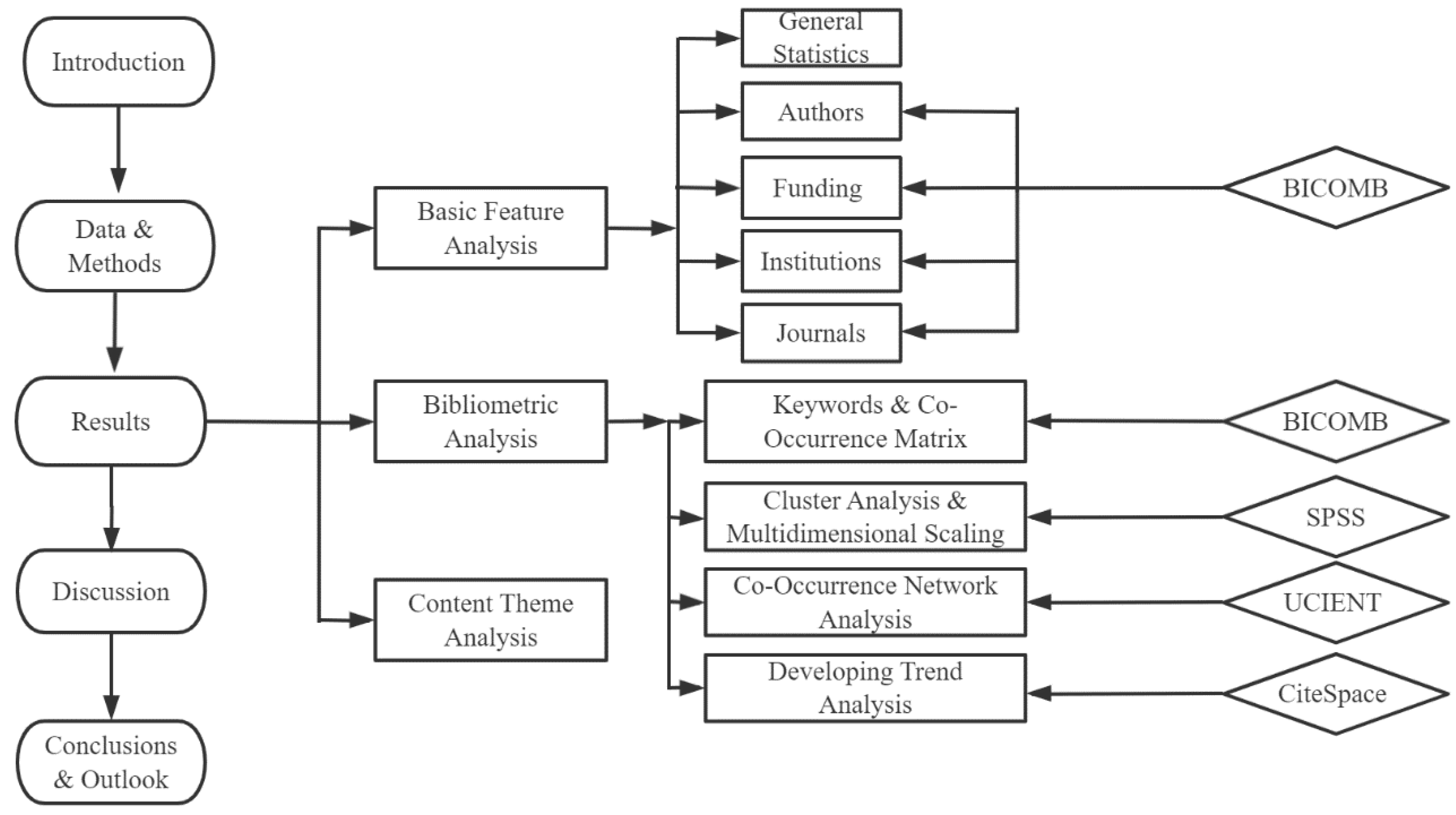

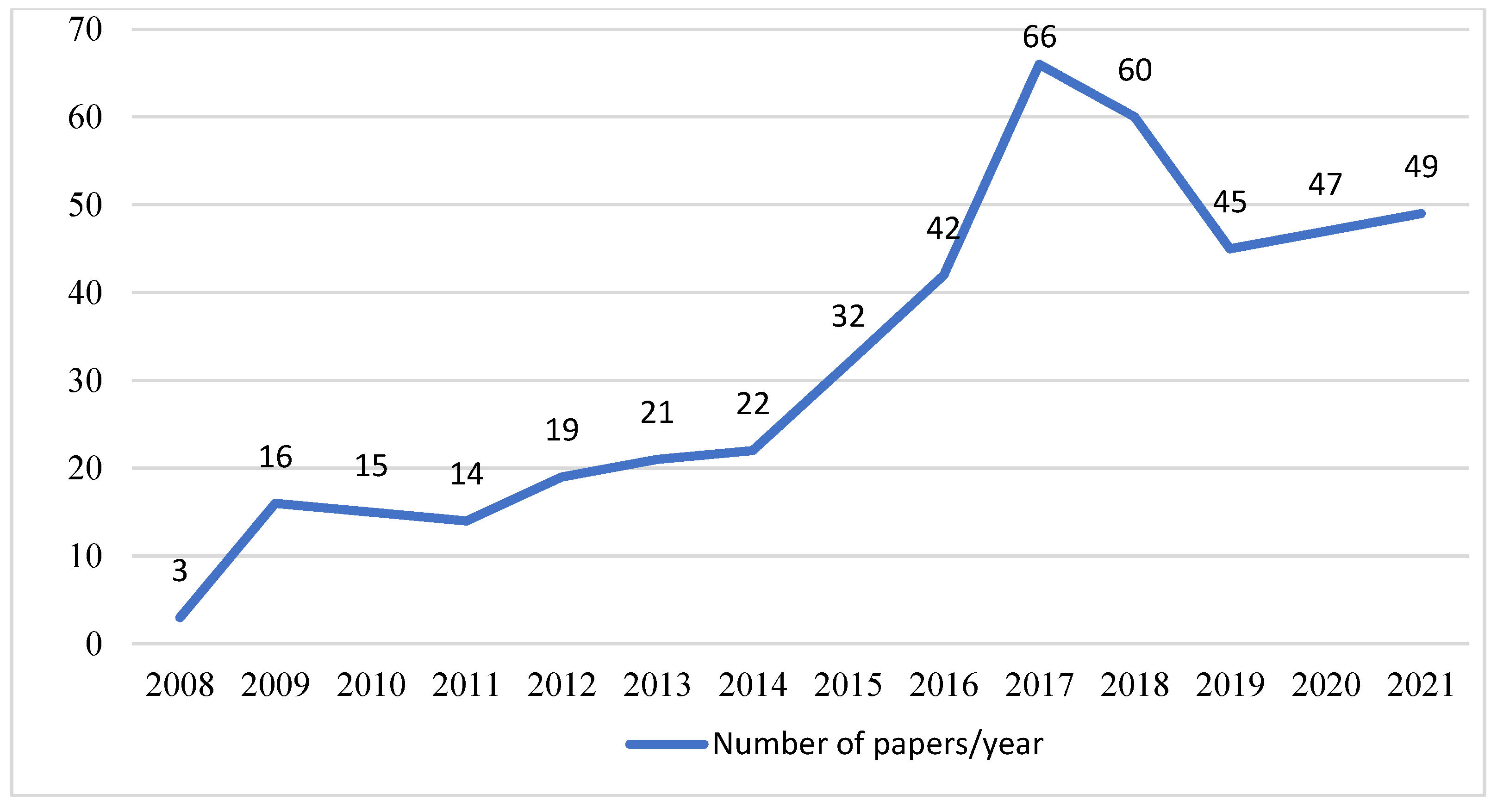

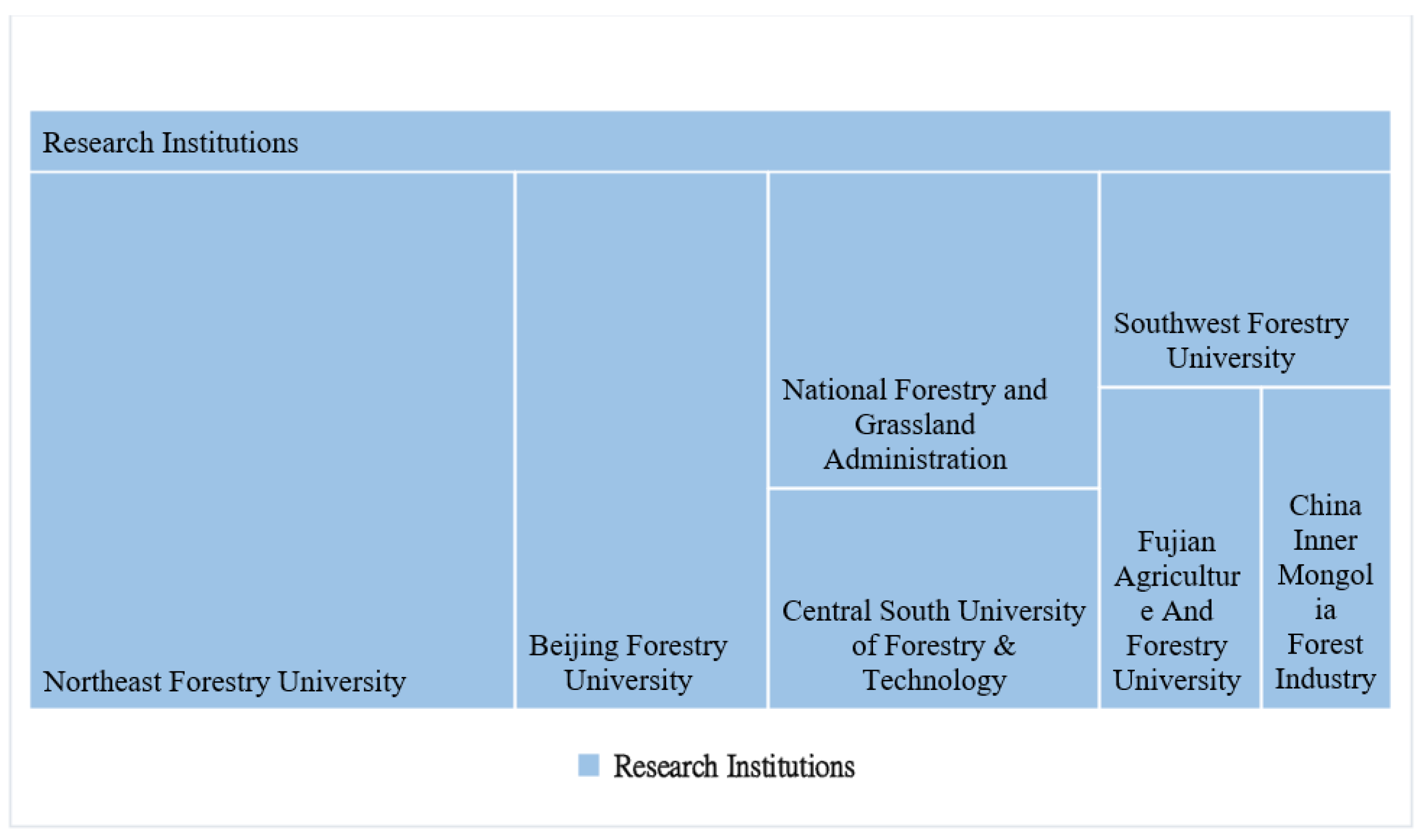


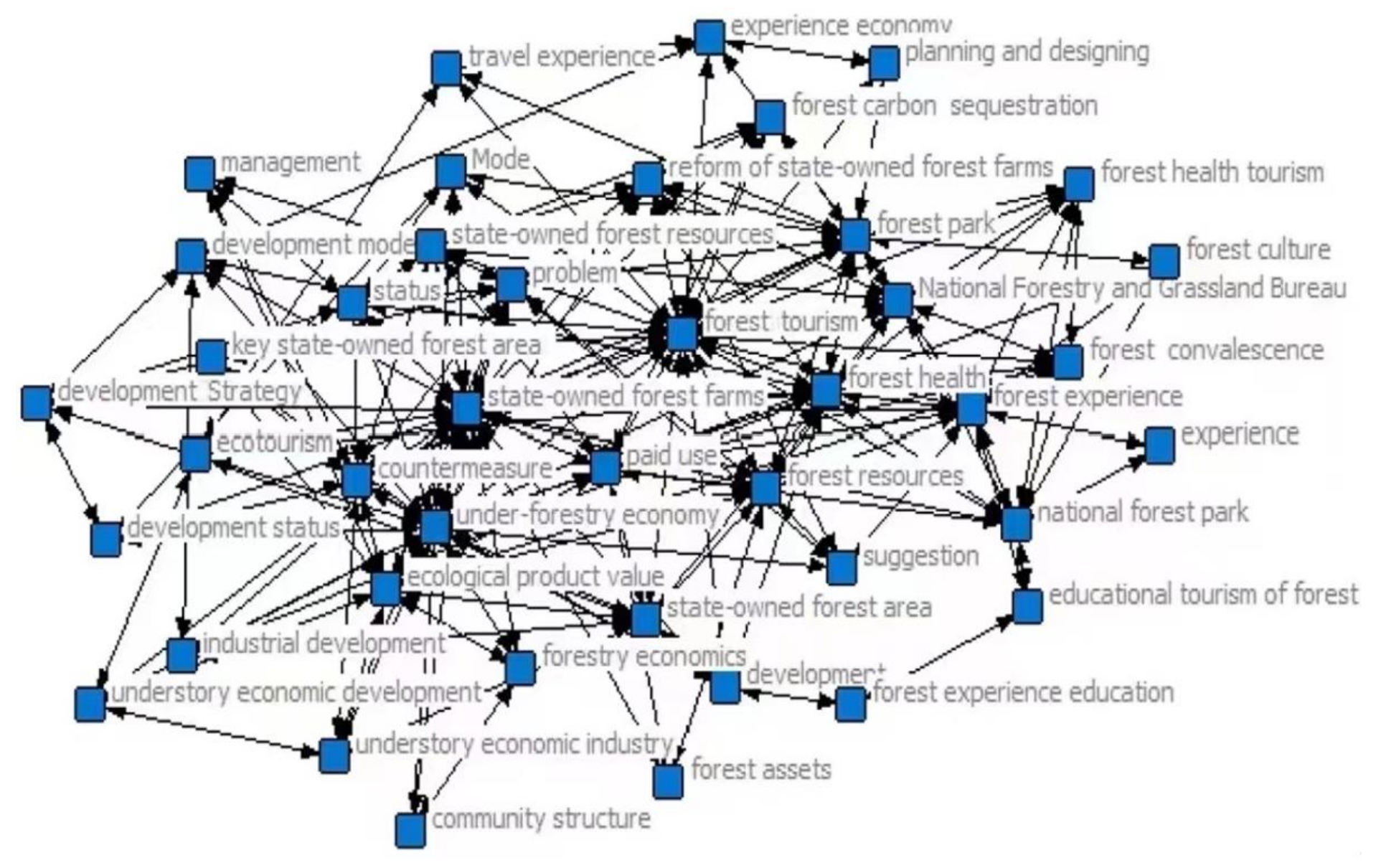
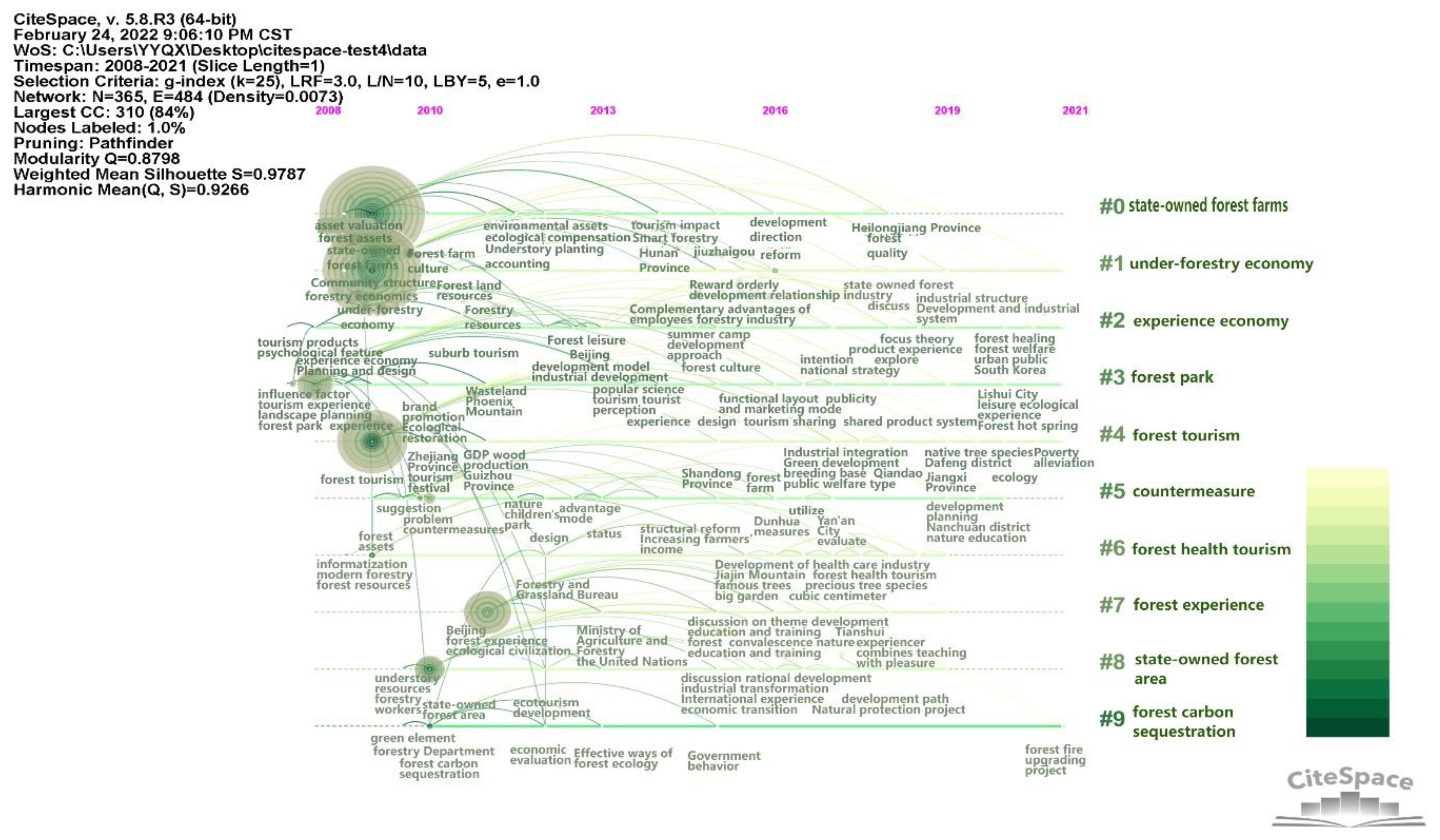
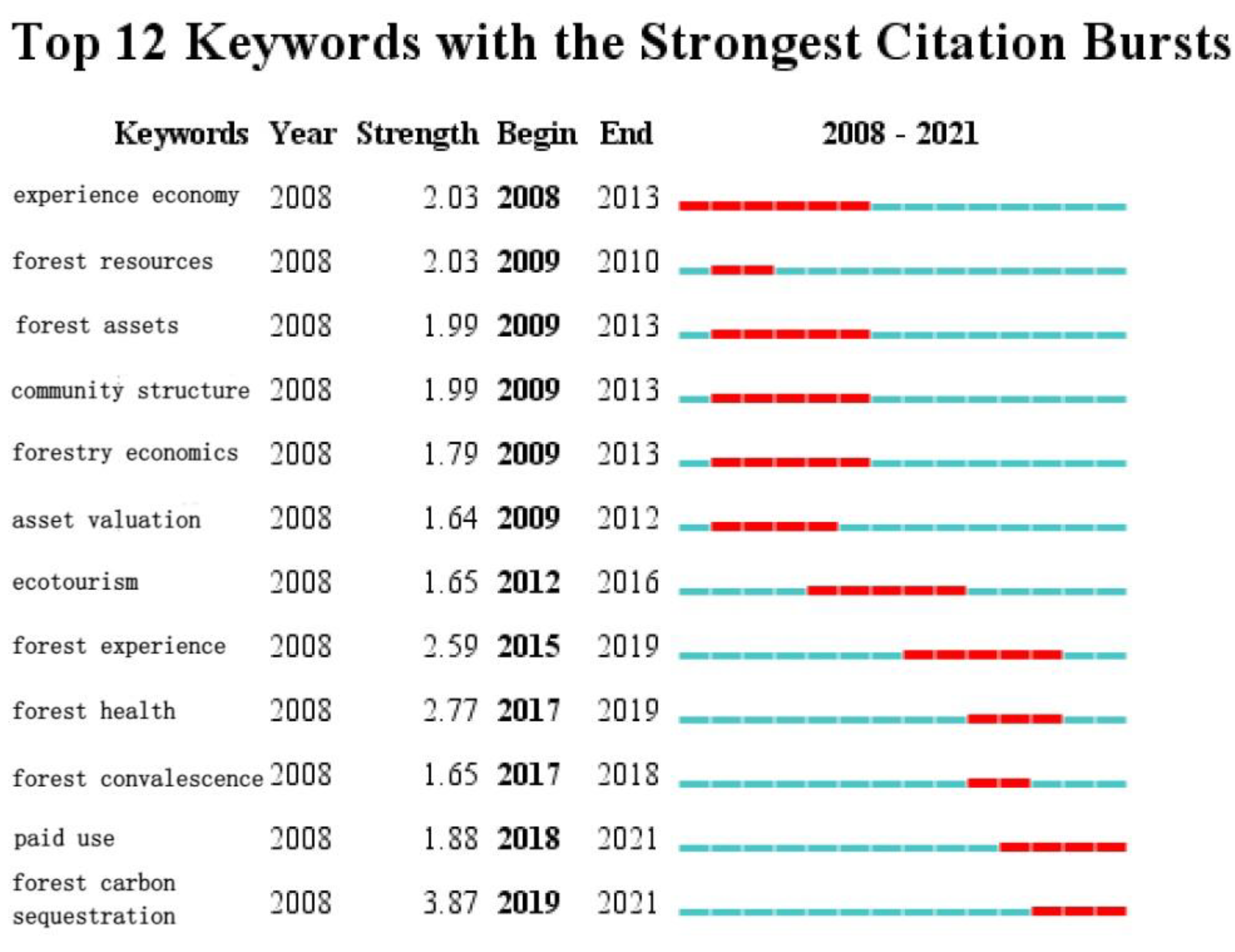
| Number | Author | Frequency | Percentage | Cumulative Percentage |
|---|---|---|---|---|
| 1 | Daling Zou | 7 | 1.552 | 1.552 |
| 2 | Hong Ma | 6 | 1.330 | 2.882 |
| 3 | Yukun Cao | 5 | 1.109 | 3.991 |
| 4 | Hongge Zhu | 4 | 0.887 | 4.878 |
| 5 | Jianyong He | 4 | 0.887 | 5.765 |
| 6 | Xiule Zhang | 3 | 0.665 | 6.430 |
| 7 | Lee | 3 | 0.665 | 7.095 |
| 8 | Xiangyue Liu | 3 | 0.665 | 7.760 |
| 9 | Minyan Zhao | 3 | 0.665 | 8.425 |
| 10 | Delin Su | 3 | 0.665 | 9.091 |
| 11 | Caixian Zhou | 3 | 0.665 | 9.756 |
| 12 | Xinfeng Chen | 3 | 0.665 | 10.421 |
| 13 | Xiping Cheng | 3 | 0.665 | 11.086 |
| 14 | Aijing Yao | 2 | 0.444 | 11.530 |
| 15 | Yongde Zhong | 2 | 0.444 | 11.974 |
| …… | …… | …… | …… | …… |
| Fund Level | Fund Type | Number of Papers | Percentage |
|---|---|---|---|
| National level | National Social Science Foundation | 7 | 11.43% |
| National Natural Science Foundation of China | 8 | ||
| National Science and Technology Support Plan | 1 | ||
| Ministerial level | Humanities (Philosophy) Social Science Foundation of the Ministry of Education | 9 | 23.57% |
| Central University Funding Project | 11 | ||
| National Development and Reform Commission Project | 2 | ||
| National Forestry and Grassland Administration Project | 10 | ||
| National Bureau of Statistics Project | 1 | ||
| Provincial level | Provincial (Philosophy) Social Science Foundation | 39 | 43.57% |
| Provincial Natural Science Foundation | 1 | ||
| Scientific Research Fund of Provincial Education Commission | 13 | ||
| Provincial Postdoctoral Funding | 8 | ||
| Department level | Office of Science and Research Fund Project | 6 | 5% |
| Department Level Soft Science Project | 1 | ||
| Municipal level | Municipal Social Science Project | 6 | 5.72% |
| Municipal Soft Science Project | 2 | ||
| School level | University Funding Project | 15 | 10.71% |
| Total | 140 | 100% |
| Rank | Research Institutions | Number of Papers | Rank | Research Institutions | Number of Papers |
|---|---|---|---|---|---|
| 1 | Northeast Forestry University | 25 | 6 | Fujian Agriculture And Forestry University; | 5 |
| 2 | Beijing Forestry University | 13 | 7 | China Inner Mongolia Forest Industry | 4 |
| 3 | National Forestry and Grassland Administration | 10 | 8 | Chinese Academy of Forestry | 4 |
| 4 | Central South University of Forestry & Technology | 7 | 9 | Heilongjiang Academy of Forestry | 4 |
| 5 | Southwest Forestry University | 6 | 10 | State-Owned Gaofeng Forest Farm of Guangxi Zhuang Autonomous Region | 4 |
| Classification | Standard of Number | Journal Type | Percentage | Number of Papers | Papers Density |
|---|---|---|---|---|---|
| Core zone | N ≥ 10 | 11 | 6.05% | 150 | 13.64 |
| Correlation zone | 3 ≤ N < 10 | 33 | 18.13% | 142 | 4.30 |
| Zero correlation zone | N < 3 | 138 | 75.82% | 159 | 1.15 |
| Total | 182 | 100% | 451 | 2.48 |
| Rank | Keywords | Frequency | Rank | Keywords | Frequency | Rank | Keywords | Frequency |
|---|---|---|---|---|---|---|---|---|
| 1 | State-owned forest farms | 104 | 15 | Understory economic development | 10 | 29 | Forest assets | 6 |
| 2 | Under-forestry economy | 94 | 16 | Problem | 10 | 30 | Planning and designing | 6 |
| 3 | Forest experience | 60 | 17 | Development Strategy | 10 | 31 | Forest culture | 6 |
| 4 | Forest tourism | 57 | 18 | Paid use | 9 | 32 | Forest experience education | 6 |
| 5 | Forest health | 53 | 19 | Forest health tourism | 8 | 33 | Suggestion | 6 |
| 6 | Forest park | 35 | 20 | Development mode | 8 | 34 | Key state-owned forest area | 5 |
| 7 | State-owned forest area | 26 | 21 | Forest carbon sequestration | 8 | 35 | Forestry economics | 5 |
| 8 | Forest resources | 16 | 22 | State-owned forest resources | 7 | 36 | Management | 5 |
| 9 | Reform of state-owned forest farms | 16 | 23 | Development | 7 | 37 | Educational tourism of forest | 5 |
| 10 | Countermeasure | 15 | 24 | Experience economy | 7 | 38 | Ecotourism | 5 |
| 11 | Ecological product value | 14 | 25 | Industrial development | 7 | 39 | Mode | 5 |
| 12 | National forest park | 14 | 26 | National Forestry and Grassland Bureau | 7 | 40 | Forest convalescence | 5 |
| 13 | Development status | 13 | 27 | Understory economic industry | 7 | 41 | Experience | 5 |
| 14 | Travel experience | 10 | 28 | Status | 7 | 42 | Community structure | 5 |
| State-Owned Forest Farms | Under-Forestry Economy | Forest Experience | Forest Tourism | Forest Health | Forest Park | State-Owned Forest Area | Forest Resources | |
|---|---|---|---|---|---|---|---|---|
| State-owned forest farms | 104 | 38 | 1 | 15 | 19 | 5 | 0 | 4 |
| Under-forestry economy | 38 | 94 | 0 | 3 | 1 | 0 | 12 | 1 |
| Forest experience | 1 | 0 | 60 | 5 | 5 | 11 | 0 | 1 |
| Forest tourism | 15 | 3 | 5 | 57 | 5 | 4 | 5 | 2 |
| Forest health | 19 | 1 | 5 | 5 | 53 | 4 | 2 | 3 |
| Forest park | 5 | 0 | 11 | 4 | 4 | 35 | 0 | 1 |
| State-owned forest area | 0 | 12 | 0 | 5 | 2 | 0 | 26 | 3 |
| Forest resources | 4 | 1 | 1 | 2 | 3 | 1 | 3 | 16 |
| State-Owned Forest Farms | Under-Forestry Economy | Forest Experience | Forest Tourism | Forest Health | Forest Park | State-Owned Forest Area | Forest Resources | |
|---|---|---|---|---|---|---|---|---|
| State-owned forest farms | 0 | 0.616 | 0.987 | 0.805 | 0.744 | 0.917 | 1.000 | 0.902 |
| Under-forestry economy | 0.616 | 0 | 1.000 | 0.959 | 0.986 | 1.000 | 0.757 | 0.974 |
| Forest experience | 0.987 | 1.000 | 0 | 0.915 | 0.911 | 0.760 | 1.000 | 0.968 |
| Forest tourism | 0.805 | 0.959 | 0.915 | 0 | 0.909 | 0.910 | 0.870 | 0.934 |
| Forest health | 0.744 | 0.986 | 0.911 | 0.909 | 0 | 0.907 | 0.946 | 0.897 |
| Forest park | 0.917 | 1.000 | 0.760 | 0.910 | 0.907 | 0 | 1.000 | 0.958 |
| State-owned forest area | 1.000 | 0.757 | 1.000 | 0.870 | 0.946 | 1.000 | 0 | 0.853 |
| Forest resources | 0.902 | 0.974 | 0.968 | 0.934 | 0.897 | 0.958 | 0.853 | 0 |
| Cases | |||||
|---|---|---|---|---|---|
| Valid | Missing | Total | |||
| N | Percent | N | Percent | N | Percent |
| 42 | 100.0 | 0 | 0 | 42 | 100.0 |
| Number | Research Topics |
|---|---|
| 1 | Research on the development status of paid use |
| 2 | Research on forest tourism and forest health |
| 3 | Research on the under-forestry economy |
| Forest Tourism | Forest Health | ||
|---|---|---|---|
| 1 | Development status of forest tourism in different regions | 1 | Industrial development of forest recreation |
| 2 | Development of the forest tourism industry | 2 | Exploration of forest recreation models and paths in different areas |
| 3 | Impact of forest tourism on the environment | 3 | Types of consumer demand for forest recreation |
Publisher’s Note: MDPI stays neutral with regard to jurisdictional claims in published maps and institutional affiliations. |
© 2022 by the authors. Licensee MDPI, Basel, Switzerland. This article is an open access article distributed under the terms and conditions of the Creative Commons Attribution (CC BY) license (https://creativecommons.org/licenses/by/4.0/).
Share and Cite
Wei, X.; Liang, C.; Chen, W. Exploring Current Status and Evolutionary Trends on the Paid Use of State-Owned Forest Resources in China: A Bibliometric Perspective. Sustainability 2022, 14, 5516. https://doi.org/10.3390/su14095516
Wei X, Liang C, Chen W. Exploring Current Status and Evolutionary Trends on the Paid Use of State-Owned Forest Resources in China: A Bibliometric Perspective. Sustainability. 2022; 14(9):5516. https://doi.org/10.3390/su14095516
Chicago/Turabian StyleWei, Xue, Chen Liang, and Wenhui Chen. 2022. "Exploring Current Status and Evolutionary Trends on the Paid Use of State-Owned Forest Resources in China: A Bibliometric Perspective" Sustainability 14, no. 9: 5516. https://doi.org/10.3390/su14095516
APA StyleWei, X., Liang, C., & Chen, W. (2022). Exploring Current Status and Evolutionary Trends on the Paid Use of State-Owned Forest Resources in China: A Bibliometric Perspective. Sustainability, 14(9), 5516. https://doi.org/10.3390/su14095516







